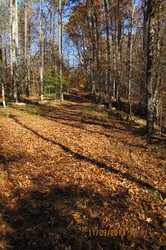 One can't wander in the Pocahontas woods in this season without noticing the dark green of Christmas fern fronds contrasting with the browns of the fallen leaves. Somehow the fronds manage to avoid being buried as all those leaves drift down. A patch of ferns such as this one is pleasing to the eye. And it will continue to be attractive through December, thus its common name. I found some interesting facts about Christmas fern here, and I quote from that site: "Christmas fern may grow in large, extensive colonial masses but more typically is found in clusters of two or three individuals. Growing ferns and the accumulated detritus of past sterile fronds form a dense covering mass over the soil surface. This mass helps to stabilize the underlying soil and prevent or lessen erosion. It also generates a protective, concealing habitat for a number of ground feeding and ground nesting bird species. Because of their complex chemical composition, ferns are eaten by very few browsers or grazers." --Ben
0 Comments
It’s a first, in all probability! The first time a team of volunteers has been organized to help manage the wild flora at Pocahontas State Park. We had our first working session today, removing Japanese Honeysuckle from the campground area. Say what? Isn’t honeysuckle that pretty flowering vine with the oh-so-sweet fragrance? You did what?
Yes, we removed the honeysuckle, at least as much as we could in three hours. It’s all about maximizing biodiversity potential. More invasive exotic plants means fewer native plants; fewer native plants means fewer native fauna (the fauna in this case being mostly insects and spiders). Fewer bugs means less food for the creatures higher up in the food chain. So IVSquad will be working to give some push-back to those exotic (i.e. non-native) plants that are stealing space from our natives. Read more about IVSquad here. --Ben Dry weather this season has meant fewer fall mushrooms than usual. And as the temperature drops, so does fungus activity. Still, there are a few mushrooms that will fruit late in the year. We have one in the park which seems not to mind the lack of rain, called Many Warts in my mushroom guide. I found a couple of them along the Bright Hope Trail this week, their size making them easy to spot. This fungus is in the Amanita family, many species of which are poisonous, including this Amanita polypyramis. The guide says they have an unpleasant odor. Perhaps that is how wildlife senses the toxicity; this fruiting bodies has not been chewed on, though deer, rodents and insects will eat some mushrooms.
--Ben Walk any forest trail these days, and you’ll be scuffling through crunchy brown, yellow and ochre leaves. It’s next to impossible to walk quietly, unless the leaves have been dampened by rain. I recently read of a forestry study that examined landscape rainfall infiltration rates. Thanks to accumulated leaf litter, a mature deciduous forest absorbs rainfall faster than any other type of landscape, reducing runoff and improving rainwater filtration. Leaf litter facilitates infiltration by providing habitat for detritivores, the small creatures in our world who make all of our organic wastes disappear. The detritivores, in turn, are part of the food chain for other creatures who, mostly unseen by us, till the soil on the forest floor, opening it up to absorb rainwater. This year’s leaf litter forms a cover over last year’s litter, providing a partial moisture barrier essential for the balance of air, moisture and organic materials that comprise detritivore habitat. By carefully digging down through the leaf litter, you can see the progression of decomposition, from the new leaves on top to the humusy soil below.
--Ben  There is a short list of things needing to be done at the Native Plant Garden. One of those is to finish spreading the mulch which I stockpiled at the upper end during the summer. The last time I worked on that, I was busy forking the mulch out of the pile when I discovered a toad in my workspace. Today I was again forking mulch into buckets when a toad appeared as if spontaneously. Was this actually the same toad? No way to know, but I did take some time later to identify it as an Eastern American Toad, Bufo americanus americanus. This poor thing has been taking advantage the habitat I inadvertently created for it, and would probably like to spend the winter there, snuggled down in the “warm”, damp mulch. Perhaps I’ll leave just one little pile of mulch for it. --Ben |
The NaturalistThoughts on the park, its residents and how to preserve its natural beauty. Archives
September 2019
Categories
All
|







 RSS Feed
RSS Feed
